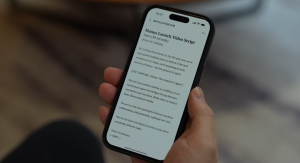Cisco bets on the future of video with contest: What do you wish your TV could do?
![]() Cisco is doing its research in coming up with a contest designed to engage constituents interested in video platforms, and produce a smart video that portrays how video content could integrate with your TV in the future. Titled, “If your TV could do anything, what would you want it to do?” the contest throws down the gauntlet in asking for the best idea of what the future of TV should look like.
Cisco is doing its research in coming up with a contest designed to engage constituents interested in video platforms, and produce a smart video that portrays how video content could integrate with your TV in the future. Titled, “If your TV could do anything, what would you want it to do?” the contest throws down the gauntlet in asking for the best idea of what the future of TV should look like.
Where did the idea come from? While researching the dynamics in the future demand for mobile content, Cisco pulled together statistics in indicating the potential growth in video over a wide array of platforms in the not too distant future. Referencing Cisco Visual Networking Index: Global Mobile Data Traffic Forecast Update, 2009-2014, Cisco confirms the prediction in exponential growth in the way video is accessed in the future and maybe how your TV screen will interact with these platforms, where an increasingly mobile market is set to explode in capturing video. This in turn, sets the stage for how video could end up on your TV from many different venues.
From E-911 responders, police, and various security measures for government entities, both mobile and wireless technologies will allow real-time video of actual events taking place from external locations throughout the world. Cisco addresses current applications in helping communities to discover the benefits of such use with, Cisco Outdoor Wireless Solutions for Mobile and Wireless Video Communications and how it can help protect the safety and welfare of communities and their citizens.
Benefits:
Reduced danger to enforcement personnel
Safer citizens
Quicker response to incidents
Advance information in the field
Full connectivity on any platform
Easier installation while saving space and power
Appendix B: The Cisco VNI Global Mobile Data Traffic Forecast Methodology
Cisco predicts that it will not be the connection which will be the central traffic driver, but the device itself from the likes of smartphones, non-smartphones, laptops/tablets/netbooks, e-readers, digital still cameras, digital video cameras, digital photo frames, in-car entertainment systems, and handheld gaming consoles. It also forecasts the inclusion of the fundamental drivers in mobile data traffic coming from available variables like connection speed, pricing of connections and devices, computational processing power, screen size and resolution, and even device battery life.
TV does not necessarily mean, (TV in the traditional sense)
What does all this mean for consumers and businesses? The TV can be any kind of mobile device capable of capturing video and processing it across multiple platforms. Where will your TV screen be in the next two to three years? How will you view TV from a more traditional aspect? It certainly does not seem to reference the big screen home TV in a historical context, but forecasts the external access to video that can be captured, viewed and then uploaded to your big screen as a caveat. It will be as much a business concept and a personal one. However, do expect and get ready for unprecedented growth in video content applications for the mobile TV screen in the coming years.
A message from John Furrier, co-founder of SiliconANGLE:
Your vote of support is important to us and it helps us keep the content FREE.
One click below supports our mission to provide free, deep, and relevant content.
Join our community on YouTube
Join the community that includes more than 15,000 #CubeAlumni experts, including Amazon.com CEO Andy Jassy, Dell Technologies founder and CEO Michael Dell, Intel CEO Pat Gelsinger, and many more luminaries and experts.
THANK YOU















